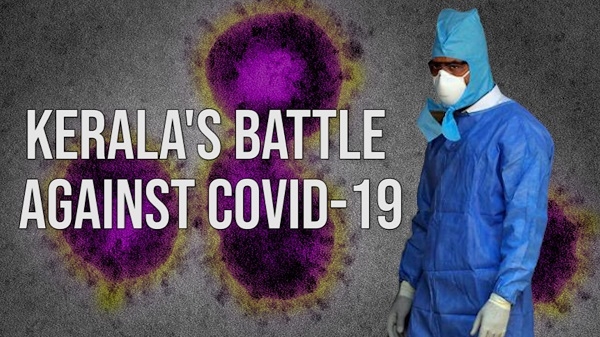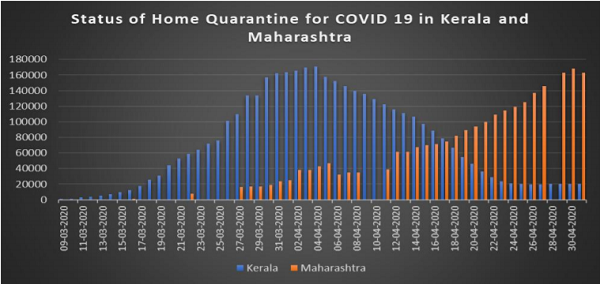8 lessons to learn from Kerala for improved control of COVID 19 in Maharashtra
Total Views |
-Siddhi Somani
The number of coronavirus cases show no sign of flattening down. They have kept increasing across India but there is one state which is clearly winning the fight against COVID-19, amd that being Kerala. Some of it is because of quick and careful decisions they took, some of it is also because of infrastructure and healthcare model that already exists in the state. Why not understand what rest of India can learn from the Kerala model?
Kerala is the fourth best state in the country in terms of doctor availability. Also the Health index 2019 by NITI Ayog states that Kerala is the best state in terms of healthcare in India. It spends more than 5% of its GDP for healthcare while India as a country only spends 1.29% of GDP on Healthcare. While there are many other states that are free from the corona fear now, Kerala model is the one to laud. This is because earlier in the month of March, it was the most affected state and now has come down to 0.01% of corona patients of all.

Kerala’s largely effective initiatives to control the COVID 19 crisis until now can provide some key learnings for other states to emulate. The strategy involves a combination of initiatives, some important ones are given below:
a. The state government instituted aggressive mitigation measures early which included screening of passengers returning from abroad, quarantining suspected cases, tracing and isolation of contacts, testing of suspected cases and treatment of positive cases.
b. Kerala introduced strict quarantine protocols much earlier than the rest of the country. By March 10, the state was screening all international passengers irrespective of the origin of departure.
c. Kerala has a much higher rate of contacts traced per case, 100 on average per lab confirmed case. As of 14 April 2020, 107075 people, of whom 106511 were in home quarantine and 564 were quarantined in hospitals (DHS, Kerala). This was much higher compared to Maharashtra which had 68256 in home quarantine despite a much higher case load (MEDD, Maharashtra). The wave of home quarantine in Kerala began to decline from early April onwards as the number of new cases reduced. Fortunately, the numbers under home quarantine in Maharashtra have now climbed from mid-April onwards, even though these were slow to rise initially during March and first half of April.

d. Kerala also aggressively tested the suspected cases and so far, has one of the best testing figures in the country. The state has done 510 tests per million and the figures have been consistently high ever since the state started the containment efforts (DHS, Kerala). There was a significant increase in the testing capacity from one designated lab for COVID 19 testing to twelve as of 9th April.
e. The state also ramped up the existing public health infrastructure, by designating one dedicated COVID 19 hospital in each district. The government expedited the filling up of human resource vacancies to meet the expected increase in demand. It recruited 276 doctors in a day from the existing rank list of the state public service commission. Most of the mitigation efforts were streamlined at the local level by mobilising the grassroots level health workers.
f. Risk communication is key in controlling any epidemic and the state government effectively utilises the local media to make people aware of the gravity of the situation. The Chief Minister’s daily press briefings have been very popular among the populace because of its nuanced explanation of the measures taken by the government, and transparency in relaying data.
g. Kerala government empowered the Panchayat bodies, leading to a bottom up approach in managing the crisis. The government enlisted large number of volunteers to do contract tracing and surveillance. The state’s vast network of women led self-help groups have played a major role in supplementing the government activities by running community kitchens and relief centres for the poor as well as migrant workers.
The state government also ensured that large number of people placed in home quarantine are well supported physically and mentally, and that containment measures are not enforced with coercion or through punitive measures, rather ensuring active community participation.
One notable impact of these intensive measures has been that the COVID 19 cases in Kerala have until now been mostly confined to recent travellers and their known contacts. The figures today demonstrate how the epidemic in Kerala until now has been effectively contained to travellers and their contacts, with contained further spread and minimal community transmission – definitely an achievement considering that Kerala was the first state in India to receive COVID cases, and keeping in mind its large number of returning travellers.
It is important for the country to implement the said practices especially because there are all indications that unfolding across various stages, the epidemic may significantly affect health and lives of people in the state over at least next three to six months. Greater responsiveness by the state machinery, ensuring that commitment for epidemic control is strongly shared by state and society through dialogue processes, and appropriate forms of social involvement based on systematic and well designed, regular mass communication - these seem essential for all of us to collectively counter this challenge of such magnitude and complexity.

